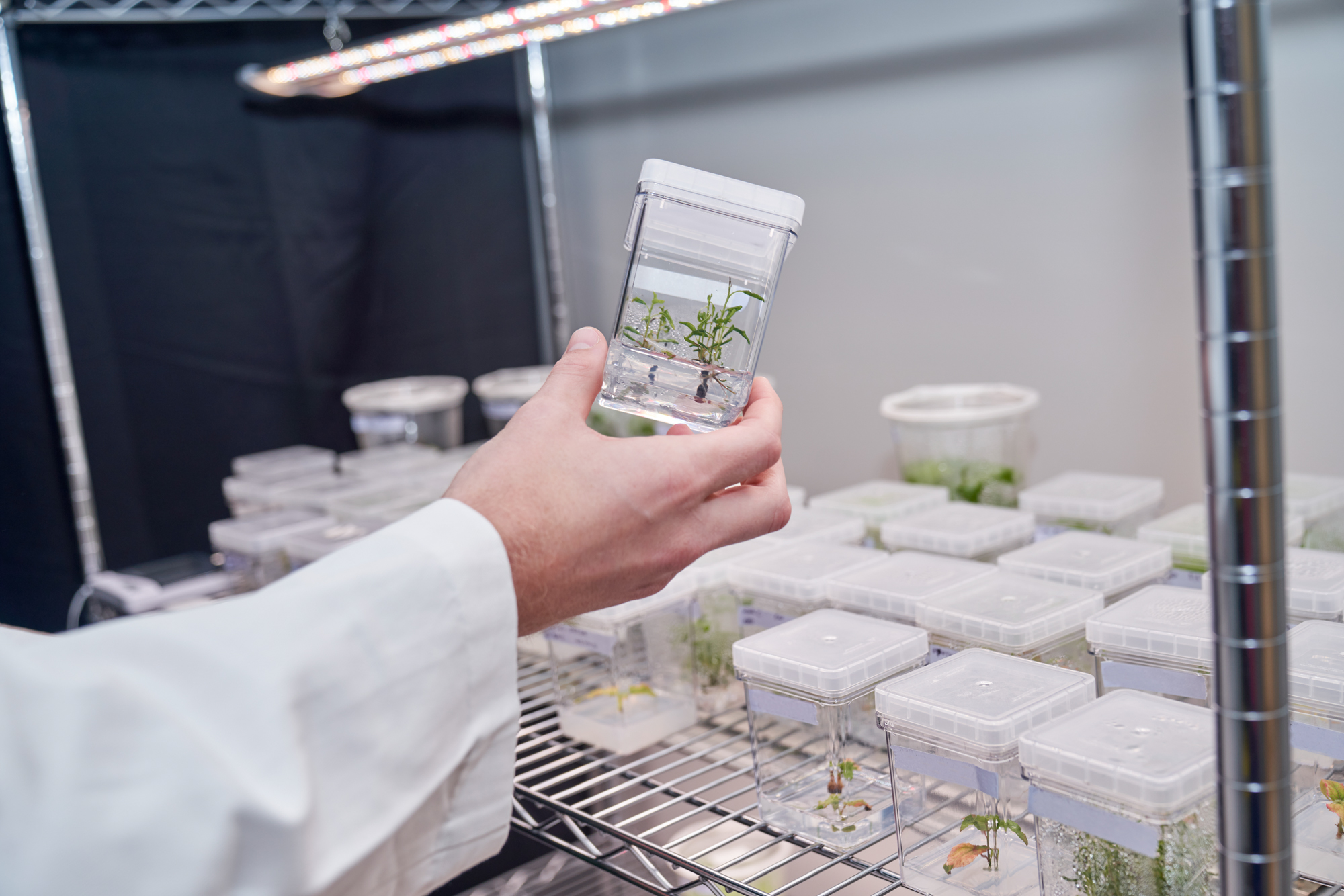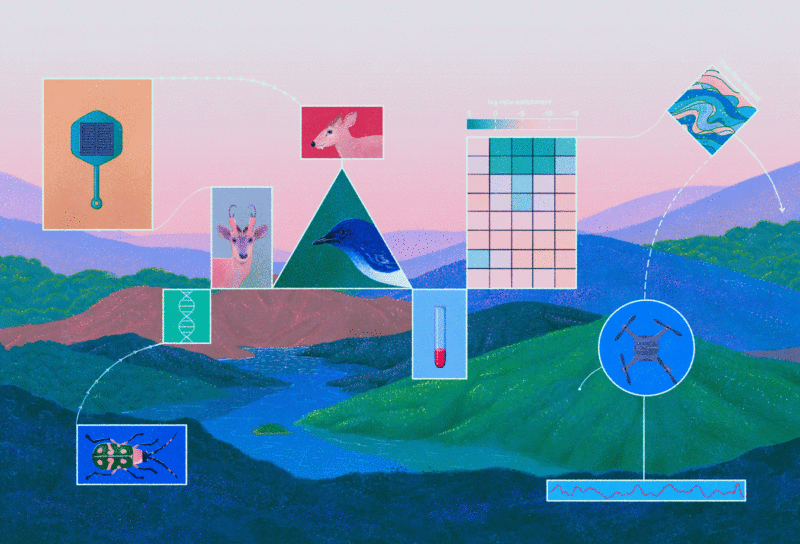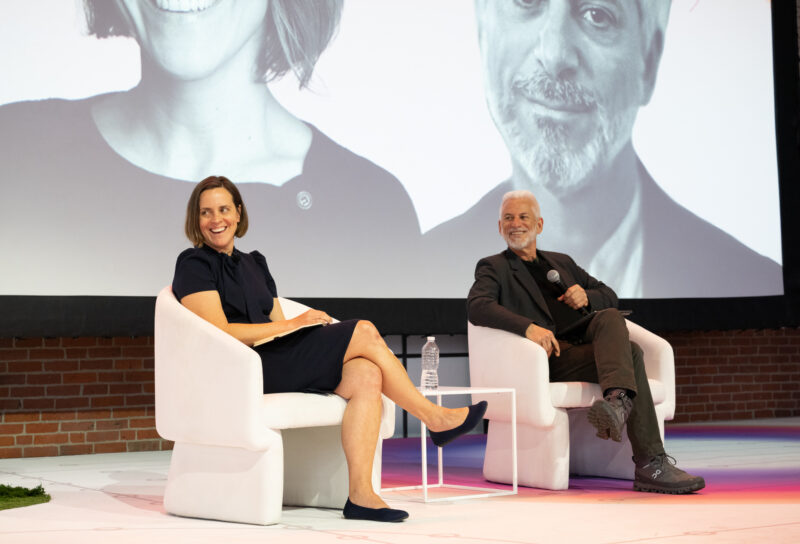Before Maddie Hall started the carbon capture company Living Carbon, she anticipated just one prerequisite: this thing needs to be big. The problem, as she saw it, was enormous: global carbon dioxide emissions exceed 30 billion tons each year. So the solution must be too. Carbon capture and storage technologies have a lot of promise, but they would need to capture a ton of carbon — or, rather, gigatons of carbon — to even make a dent. So Hall set her sights on a biological idea she deemed ready to explode out of the lab and into the world. In 2019, she cofounded Living Carbon.
The biotech company’s mission is to harness photosynthesis for carbon capture. Their approach involves enhancing photosynthesis in hybrid poplar trees to help them grow faster and become more effective at storing carbon as biomass. After multiple generations of testing, their lead poplar seedling demonstrated a 53% increase in producing above ground biomass. All of that biomass constitutes carbon that’s now fixed as plant matter, rather than vaporized in the atmosphere as planet-warming emissions. And early evidence from field trials is revealing some surprising benefits in tough landscapes.
Living Carbon planted their first genetically modified trees in a Georgia forest this February. But they’re quickly evolving beyond just a tree company. Last year they announced a project to produce sporopollenin — a tough biopolymer that can store carbon without decaying — in fast-growing microalgae. What does this all mean for the company’s past, present, and (hopeful) future? GROW recently spoke with Maddie Hall to find out.
Tell us about the origin of Living Carbon.
Hall: Back in 2019, a lot of money and talent was being funneled into AI and machine learning. There really wasn’t that large of an ecosystem of climate startups at all. I spent some time working on hard science projects at Y Combinator, including their very first request for carbon sequestration companies. At OpenAI, I really appreciated working in an area that aligned with my values and would be impactful in the next 10-20 years. I learned a lot about how to make something that sounds impossible — but actually isn’t — become real. So I set out to start the OpenAI of synbio-based carbon removal. And I decided to work on developing photosynthesis-enhanced trees as the first project.
So… why trees?
I think of the benefit that trees have provided to humans throughout our history, like firewood and places to hide under in a storm. It’s allowed us to accelerate our growth and advance societies — without the carbon stored in our Earth, humans would not be where they are today. And so I think it’s our duty and our obligation to try to help those ecosystems survive using the technology that we’ve developed.
Working with plants is very life-giving. Walking into one of our grow rooms and smelling the trees, just being around them — it’s incredibly energizing. I have a new appreciation for the power of biology. To see a callus cell in a petri dish start to make roots and shoot, and get transferred to a magenta box, and then be grown aseptically, transferred to soil, grown in the greenhouse study, become 15 feet tall, and be planted in the wild is really an incredible thing to be a part of.
It’s also based on learning what is effective in other plants. We can help our ecosystems become more resilient to climate change by using traits to make C3 plants achieve a similar degree of photosynthetic efficiency as C4 plants, without having to make any anatomical changes. You can use genetic engineering not just to increase crop yield, but to actually help improve biodiversity. As a result of both of those things, Living Carbon is structured as a public benefit corporation where we can create value for our shareholders and also take actions that align with our mission. And that mission is large-scale biological carbon sequestration, focused on improving the rate of photosynthesis and the durability of carbon stored.
Most carbon capture companies aren’t employing biology, which underpins the carbon capture we see in nature. What opportunity did you see in working with synthetic biology?
Photosynthesis enhancement has been worked on for decades by incredibly talented people within plant biology. And the poplar had previously been engineered to grow faster and remove commonly found carcinogens from soil.
Other types of carbon removal, whether that’s mineral weathering, or direct air capture, all require a large amount of energy. And it can be renewable energy, but still even producing that amount of energy is a challenge. To remove the amount of CO2 that we need to remove with direct air capture, I’m pretty sure it requires a [sizable portion] of all of the energy in the world, which is a lot.
We can scale because the infrastructure already exists. Other carbon removal methods require building facility after facility. That requires time, it requires people, and generates emissions. People already plant 1.6 billion trees per year. And that’s in the US alone. Our suppliers plant 300 million trees a year.
You’re also working with algae, in addition to poplars. What’s the focus of that work?
Our long-term goal is to create some sort of organism that uses energy from the sun to durably sequester carbon for at least 1,000 years, and to really prevent the decomposition of biomass. Actually, from a gigaton-scale perspective, by preventing the decomposition of biomass you get an additional 10 gigatons of CO2 per year. Sporopollenin is a highly durable biopolymer that is as close to biologically inert as you can get. So it’s a really high impact area to work on.
We don’t know whether the ideal method of carbon capture is trees or algae — I think it’s both. There’s not going to be a silver bullet. It really depends on the type of land that you’re working on. Think about deserts. Think about the Salton Sea. There’s a lot of areas where it actually wouldn’t make sense to plant trees but it does make sense to have a cheap bioreactor, because there’s a lot of sun.
Addressing climate change takes a lot more than just the technology, of course. Can you speak more about the Living Carbon business model and what’s been most surprising to you as you’ve built the company?
The biggest challenges that we’ve faced have been working within pretty old school carbon markets. As a supplier, we’re trying to design for the carbon markets that will exist in two years. There are a lot of traditional nonprofit gatekeepers that need to exist, because they’re a way to actually create a security out of the carbon price. However, they aren’t really able to adapt as quickly as the industry needs to scale.
I think most surprising is our deployment strategy. We’re not just growing our trees on land where trees are already growing. It’s much more focused on abandoned mine lands. Areas where trees might otherwise not be growing, or would definitely not be planted. Areas of fossil fuel extraction that don’t have any other viable paths without the use of carbon credits — the lowest quality land, but it results in the highest quality projects. We’ve seen a pretty high survivability rate for our poplars in mine land projects.
At one of our sites in Pennsylvania — a former surface mine — some landowners have tried planting native species. They got a 90% mortality rate. In our reforestation project there, we’ve seen about 97% survivability. That’s due to a lot of factors: working with a really good planting crew, the fact that we did the proper site prep, but the trees’ genetics also helped a lot.
You’re the first group to plant genetically modified trees in US forests; what assuages your fears about introducing GMOs in the wild?
Our trees are susceptible to the same blight and diseases as other trees but they don’t produce any pollen. We’re not trying to plant any monocultures. That would be a very bad idea for many reasons. If anything, [our trees] should help improve biodiversity.
In many cases, the soil that we’re planting on is not high quality at all. And so, having more biomass below and above ground can actually improve the soil quality.
On the site that I mentioned, one of the reasons for the high mortality of the previous forest stand was because of invasive grasses. The native trees were growing so slowly that they weren’t able to push out the invasive grasses. By using fast-growing, photosynthesis-enhanced trees, we’re able to establish forest cover and allow the new species to actually thrive.
You can use genetic engineering not just to increase crop yield, but to actually help improve biodiversity.
Living Carbon recently raised $21 million in Series A funding. How do you see your work scaling in the future?
When you’re propagating a plant, it is very easy to exponentially increase the number of cuttings you get. We planted 100,000 [hybrid] trees last month. We’ll plant 100,000 next month, and the following month. Eventually, we’ll start planting a million — getting up to a factor of 10. That’s the benefit of biology, right? Plants use energy from the sun. They don’t necessarily require outside energy inputs to capture additional carbon every year.
By the spring of 2024, we will be planting 4 to 5 million photosynthesis-enhanced poplars. We’re already starting to scale our first commercial product.
You’ve described Living Carbon as “the OpenAI of synbio-based carbon removal,” in reference to the firm that’s produced AI innovations like ChatGPT. What are the parallels?
OpenAI did a really good job of providing opportunities for folks who were working on machine learning to work on something that was both frontier and also commercial. Prior to OpenAI and other startups that now exist, you had a couple of options. You could either go run a machine learning team at a company that was incorporating machine learning tactics, or you could go to academia. Obviously, that’s changed now. But there are similarities in synthetic biology for carbon removal. For folks that go into plant biology, a lot of the work centers around either academic research, or working at a large chemical or crop science company. And in reality, most people who go into the industry do so because they love plants and they care about the planet, not because they want to work at DuPont. We had a similar path for people wanting to make an impact in the world, but also wanting to do frontier research and not have all their research stuck in the lab. That was one similarity.
The other similarity was that synthetic biology and genetic engineering are somewhat controversial. AI has a lot of potential to create highly personalized education that’s high quality for everybody. But those stories aren’t told, or they weren’t at the time. Instead, most of the images that we had of advanced AI systems were scary, [dystopian] images from science fiction novels. And it’s the same thing for genetic engineering. Our challenge is to determine how we can avoid making mistakes that are commonly portrayed in pop culture. There aren’t many references [in popular media] to all that genetic engineering has done to actually solve grand challenges. Which is silly, because that’s why these technologies exist, right? To improve the overall well-being and quality of human life. Genetic engineering — and I’m preaching to the choir here — has the potential to eliminate malnutrition in the world.
This conversation has been edited for length and clarity.



